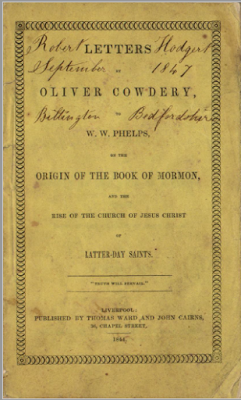I’ve mentioned the 1844 pamphlet published in Liverpool that includes Letter VII.
The Millennial Star began publication in May 1840. The second issue, June 1840, contained excerpts from Oliver’s letters. The first letter was published in full in January 1843, accompanied with a promise to publish all of them in a pamphlet.
Oliver was not a member of the Church when these reprints were published, but he had been Assistant President of the Church when he wrote the letters and members considered them important and authoritative (unlike Phelps’ answers, which were never approved by Joseph Smith or reprinted).
This publication history shows that Oliver’s letters were reprinted continuously from 1840 through 1847 with Joseph’s express permission and encouragement, as well as his implicit approval.
You can see copies of the original here:
https://archive.org/details/lettersbyoliverc00oliv
and here:
http://contentdm.lib.byu.edu/cdm/ref/collection/NCMP1820-1846/id/2828
People have asked about it so here is the background information provided by Peter Crawley, who has done a phenomenal job with his Descriptive Bibliography.
This entry is available here:
https://rsc.byu.edu/es/archived/descriptive-bibliography-mormon-church-volume-1/entries-101-200.
197 COWDERY, Oliver. Letters by Oliver Cowdery, to W. W. Phelps, on the origin of the Book of Mormon, and the rise of the Church of Jesus Christ of Latter-day Saints. Liverpool: Published by Thomas Ward and John Cairns, 36, Chapel Street. 1844
Source: Letter VII
